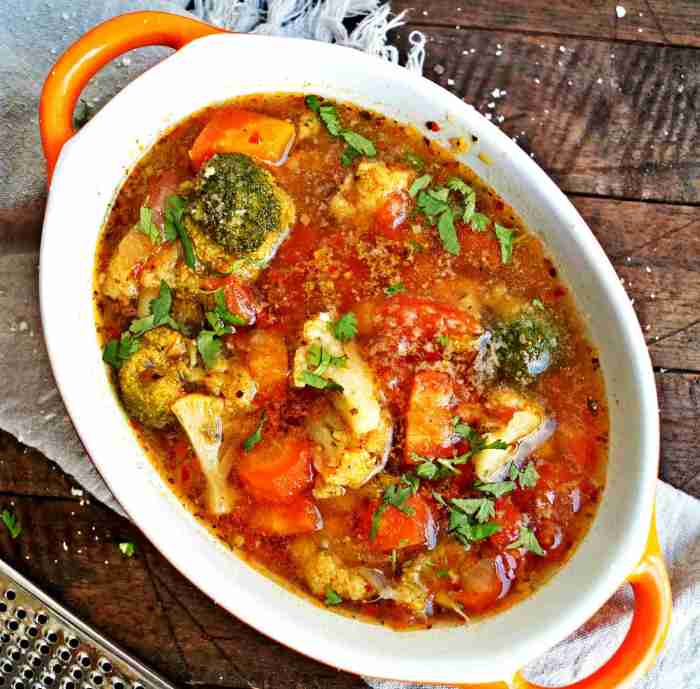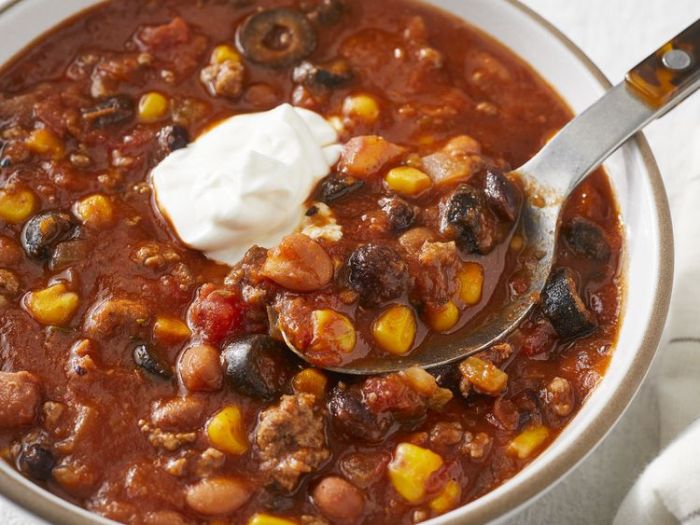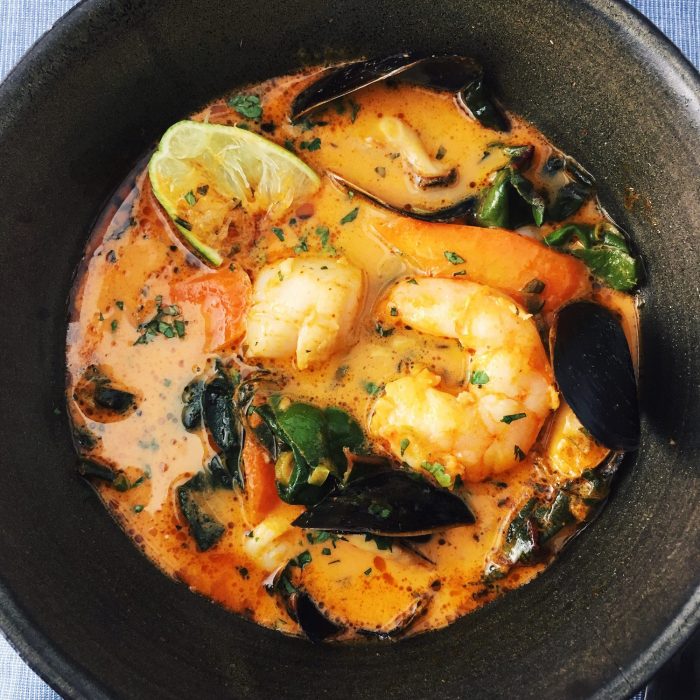Broccoli Cauliflower Soup Recipe Variations: Recipe For Broccoli Cauliflower Soup

Source: frommichigantothetable.com
Recipe for broccoli cauliflower soup – This versatile soup offers endless possibilities for customization. Exploring different cooking methods and ingredient substitutions allows for a wide range of flavors and textures, catering to various dietary preferences and tastes. Below, we delve into three distinct variations, ingredient substitution options, and techniques for achieving your desired soup experience.
Recipe Variations: Creamy, Brothy, and Roasted

Source: archanaskitchen.com
Three distinct approaches highlight the versatility of this soup. Each variation utilizes different cooking techniques to achieve unique flavor and textural profiles.
- Creamy Broccoli Cauliflower Soup: This version involves simmering the vegetables until tender, then blending them with cream or coconut milk for a luxuriously smooth and rich texture. Key ingredients include broccoli florets, cauliflower florets, vegetable broth, onion, garlic, cream/coconut milk, and salt/pepper. The creaminess adds richness and depth to the vegetable flavors.
- Brothy Broccoli Cauliflower Soup: This lighter variation features a less-thickened broth, allowing the individual vegetable flavors to shine. The vegetables are simmered in broth, and only partially blended for a slightly chunky texture. Key ingredients are broccoli, cauliflower, vegetable broth (or chicken broth for a richer flavor), onion, garlic, and herbs like thyme or rosemary. The lighter broth complements the vegetables’ natural flavors.
- Roasted Broccoli Cauliflower Soup: Roasting the vegetables beforehand intensifies their natural sweetness and adds a depth of flavor unmatched by simply simmering. After roasting, the vegetables are simmered in broth and then blended to a creamy or chunky consistency. Key ingredients include broccoli, cauliflower, olive oil, salt, pepper, garlic, and vegetable broth. The roasting process contributes a nutty and slightly caramelized flavor.
The creamy version offers a rich, decadent texture and a smooth mouthfeel, while the brothy version provides a lighter, more refreshing experience with a subtle chunkiness. The roasted version delivers a deeper, more complex flavor profile with a slightly caramelized sweetness.
Ingredient Substitutions
Several vegetables can successfully replace broccoli and cauliflower, each impacting the soup’s taste and texture. Similarly, alternatives exist for other ingredients to accommodate dietary needs or preferences.
- Broccoli Substitutes: Kale (adds a slightly bitter note and a tougher texture), spinach (milder flavor, softer texture), Brussels sprouts (nuttier flavor, firmer texture), green beans (crisper texture, slightly sweeter flavor), Romanesco (similar flavor to cauliflower, unique fractal appearance).
- Cauliflower Substitutes: Kohlrabi (mildly sweet, slightly crisp), turnips (slightly peppery and earthy), parsnips (sweeter, slightly more dense), rutabaga (similar to turnips but milder), potatoes (adds creaminess and starchiness).
- Broth Substitutes: Water (simplest option, less flavor), bone broth (adds richness and umami), coconut broth (for a creamy, subtly sweet flavor).
- Milk/Cream Substitutes: Coconut milk (creamy, subtly sweet), cashew cream (rich and creamy, vegan), silken tofu (creamy, neutral flavor, vegan).
- Seasoning Substitutes: Experiment with different herbs and spices to achieve your desired flavor profile. For instance, instead of salt and pepper, try a blend of cumin, coriander, and turmeric for a warming spice blend.
Vegan adaptations easily swap dairy cream for coconut milk or cashew cream. Gluten-free diets require ensuring all broth and seasonings are gluten-free.
Cooking Techniques
Preparing broccoli cauliflower soup is straightforward, involving simple steps. Puréeing methods significantly influence the final texture.
- Sauté diced onion and garlic in olive oil until softened.
- Add chopped broccoli and cauliflower; cook for 5-7 minutes.
- Pour in vegetable broth; bring to a boil, then simmer until vegetables are tender (about 15-20 minutes).
- Purée the soup using your chosen method (see table below).
- Season with salt, pepper, and any additional spices or herbs.
- Heat through and serve.
| Puréeing Method | Pros | Cons | Texture Achieved |
|---|---|---|---|
| Immersion Blender | Convenient, easy to clean, purées directly in the pot | May not achieve perfectly smooth results with fibrous vegetables | Smooth to slightly chunky |
| Regular Blender | Achieves a very smooth texture | Requires transferring hot soup, potential for splattering | Very smooth |
For a smooth texture, fully purée the soup until completely blended. For a chunkier texture, partially purée the soup, leaving some vegetable pieces intact.
Flavor Enhancements
Adding different spices and herbs significantly alters the soup’s flavor profile. Garnishes further enhance the visual appeal.
A creamy broccoli cauliflower soup is easily customizable; you can add various herbs and spices to enhance its flavor profile. For a deeper, richer onion flavor base, consider using a pre-made mix like the onion recipe soup and dip mix as a foundation before adding your broccoli and cauliflower. This adds a savory depth that complements the vegetables beautifully, resulting in a more complex and satisfying soup.
- Spicy: Cayenne pepper, chili flakes, chipotle powder, ginger.
- Cheesy: Nutmeg, Parmesan cheese (or nutritional yeast for vegan option), cheddar cheese.
- Herby: Fresh thyme, rosemary, parsley, dill, chives.
- Optional additions for visual appeal: A swirl of cream, chopped fresh herbs, toasted nuts, croutons, a drizzle of olive oil.
Serving Suggestions
This soup’s versatility makes it suitable for various occasions and meal types. Appropriate pairings enhance the overall dining experience.
- Starter: Serve in small bowls as a light appetizer before a main course. Pair with crusty bread or a simple green salad.
- Main Course: Serve in larger bowls as a hearty, vegetarian main course. Accompany with a side of grilled chicken or fish, or a quinoa salad.
- Side Dish: Serve alongside a heavier main course, such as roasted meats or hearty pasta dishes. Its light flavor complements richer entrees.
For a sophisticated presentation as a starter, consider serving the soup in elegant espresso cups, garnished with a sprig of fresh thyme.
As a main course, enhance presentation by using a shallow bowl and garnishing with toasted breadcrumbs and a drizzle of high-quality olive oil.
When serving as a side dish, a simple garnish of chopped parsley is sufficient to complement the other dishes.
Nutritional Information

Source: tasteofhome.com
Broccoli and cauliflower are nutritional powerhouses, rich in vitamins, minerals, and antioxidants. The nutritional content of the soup varies based on the specific recipe and ingredients used.
| Nutrient | Amount (per serving – approximate) |
|---|---|
| Calories | 150-200 |
| Protein | 5-7g |
| Vitamin C | 20-30% DV |
| Vitamin K | 15-25% DV |
| Fiber | 4-6g |
Note: Nutritional values are estimates and can vary depending on the specific ingredients and portion sizes used. Creamier versions will generally have a higher calorie and fat content.
Storage and Reheating, Recipe for broccoli cauliflower soup
Proper storage and reheating techniques maintain the soup’s quality and prevent unwanted changes in texture.
Leftover soup should be stored in airtight containers in the refrigerator for up to 3-4 days or frozen for up to 2-3 months. To reheat, gently warm the soup on the stovetop or in the microwave, stirring occasionally to prevent scorching or separation. Avoid boiling, as this can make the soup watery.
To prevent the soup from becoming watery, avoid over-simmering during reheating. If the soup separates, a quick whisk or blend with an immersion blender can restore its creamy texture.
General Inquiries
Can I freeze this soup?
Yes, this soup freezes well. Allow it to cool completely before storing in airtight containers for up to 3 months.
How long can I store leftover soup in the refrigerator?
Leftover soup can be stored in the refrigerator for up to 4 days.
What if my soup is too thick?
Add a little more broth or water to thin it to your desired consistency.
What if my soup is too thin?
Simmer the soup uncovered for a longer period to reduce the liquid. Alternatively, you can add a cornstarch slurry (1 tablespoon cornstarch mixed with 2 tablespoons cold water) to thicken it.
Can I use frozen broccoli and cauliflower?
Yes, you can use frozen broccoli and cauliflower. Just ensure they are completely thawed before adding them to the soup.


